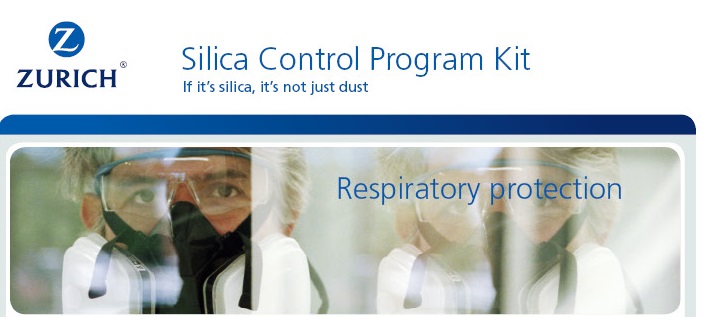

                |
According to the OSHA website on Respiratory Protection, "Respirators have their limitations and are not a substitute for effective engineering and work practices controls", which are discussed in more detail in the Controls section. "When it is not possible to use these controls to reduce airborne contaminants below their occupational exposure levels, such as during certain maintenance and repair operations, emergencies, or when engineering controls are being installed, respirator use may be the best or only way to reduce worker exposure. In other cases, where work practices and engineering controls alone cannot reduce exposure levels to below the occupational exposure level, respirator use is essential." The Silica Standards specify that respiratory protection is required:
Respiratory Protection Program
When respirators are used to control employee exposure to crystalline
silica, a comprehensive respiratory protection program must be
developed. Respirators are only effective when properly selected,
fitted, and maintained.
If
employees voluntarily wear respirators, employers must still establish
and implement certain program elements to address voluntary respirator
use. The sample Respirator Assignment and Training Record can be used to document (1) which respirators are assigned to which employees and, (2) the completion of the relevant respirator training requirements. Assigned Protection Factors and Respirator Selection
The ability of any respirator to reduce a given exposure to silica
depends primarily upon the design of the respirator. Different
respirators offer different levels of protection, and those differences
must be taken into account when selecting a respirator. ANSI, NIOSH and
OSHA, in their respirator standards and guidelines, list Assigned
Protection Factors (APF) for different respirator types. These APFs are
used to help select respirators that offer sufficient protection
against the exposure.
A respirator should be selected with an Assigned Protection Factor greater than the Hazard Ratio. OSHA recognizes that many of its PELs are outdated and inadequate for ensuring protection of worker health. To better protect workers, OSHA has annotated the existing Z-Tables with other selected occupational exposure limits, such as the ACGIH TLVs. OSHA recommends that employers consider using the alternative occupational exposure limits because the Agency believes that exposures above some of these alternative occupational exposure limits may be hazardous to workers, even when the exposure levels are in compliance with the relevant PELs. Therefore, it is suggested that respirators be worn when employee silica exposures exceed the ACGIH TLV and OSHA Action Level of 0.025 mg/m3. In the above example, the employee's 8-hour silica exposure of 0.4 mg/m3 is 16 times the TLV and Action Level. As shown in Table R-1, the Half-mask respirator has an APF of 10, which is below the Hazard Ratio of 16. Therefore a respirator should be selected with an APF of 25 or greater. The following table, taken from the OSHA Respiratory Protection Standard 29 CFR 1910.134, provides assigned protection factors for various respirator types. 1910.134(d)(3)(i)(A)
*Respirator has APF of 50 only with quantitative fit testing. (1) Employers may select respirators assigned for use in higher workplace concentrations of a hazardous substance for use at lower concentrations of that substance, or when required respirator use in independent of concentration. (2) The assigned protection factors in Table 1 are only effective when the employer implements a continuing, effective respirator program as required by this section (29 CFR 1910.134), including training, fit testing, maintenance, and use requirements. (3) This APF category includes filtering facepieces and half masks with elastomeric facepieces. (4) The employer must have evidence provided by the respirator manufacturer that testing of these respirators demonstrates performance at a level of protection of 1,000 or greater to receive an APF of 1,000. This level of performance can best be demonstrated by performing a WPF or SWPF study or equivalent testing. Absent such testing, all other PAPRs and SARs with helmets/hoods are to be treated as loose-fitting facepiece respirators, and receive an APF of 25. (5) These APFs do not apply to respirators used solely for escape. For escape respirators used in association with specific substances covered by 29 CFR 1910 Subpart Z, employers must refer to the appropriate substance-specific standards in that subpart. Escape respirators for other IDLH atmospheres are specified by 29 CFR 1910.134 (d)(2)(ii). Abrasive Blasting OSHA standards (29 CFR 1910.94 and 29 CFR 1926.57), pertaining to abrasive blasting, specify the use of abrasive blasting respirators. An abrasive blasting respirator is constructed so that it covers the wearer's head, neck, and shoulders to protect them from rebounding abrasive. Abrasive blasting respirators must be worn:
Properly
fitted particulate filter respirators, commonly referred to as
dust-filter respirators, may be used for short, intermittent, or
occasional dust exposures such as cleanup, dumping of dust collectors,
or unloading shipments of sand at a receiving point, when it is not
feasible to control the dust by enclosure, exhaust ventilation, or
other means. The respirators used must be approved by NIOSH under 42 CFR part 84 for protection against the specific type of dust encountered. NIOSH-certified, Type CE abrasive-blasting respirators are the only respirators suitable for use in abrasive-blasting operations. Currently, four Type CE abrasive-blasting respirators are certified by NIOSH:
For abrasive blasting using crystalline silica, NIOSH recommends that workers wear a Type CE, pressure-demand or positive-pressure, abrasive-blasting respirator (APF of 1,000 or higher). These protection factors are often needed because of the high silica exposures during sandblasting. Respirators for Other OperationsFor
operations other than abrasive blasting with crystalline silica, Table
R1 lists the minimum respiratory protection equipment required to meet
the OSHA PEL for crystalline silica under given exposure
concentrations. The most protective respirator should be selected
consistent with the tasks to be performed. Note: The OSHA Construction Silica Standard
(29 CFR 1926.1053) specifies minimum respiratory protection for
specific operations in Table 1.
The following sample forms can be used to document respirator selection and employee assignment of respirators. Sample Employee Respirator Assignment and Training Record (top) © 2017 The Zurich Services Corporation. All rights reserved. | ||||||||||||||||||||||||||||||||||||||